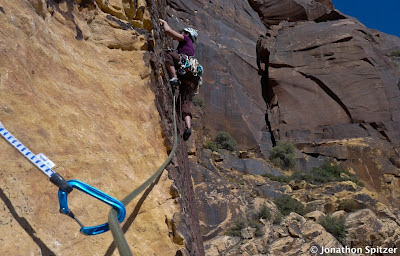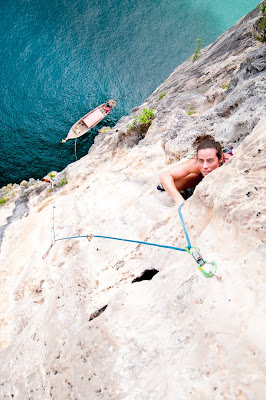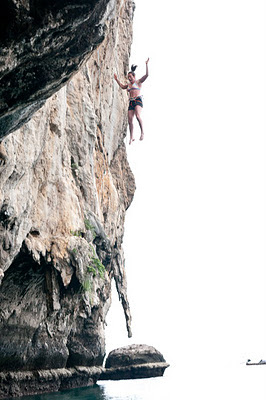On Saturday, July 28, Chad Kellogg and I made an ascent of the NE Buttress of Mt. Slesse. Since I'm moving to Salt Lake City on Saturday to begin a new career as a nurse, I was seeking a climb that would satisfy my adventurous alpine side for awhile. Mt. Slesse offered exactly the type of North Cascades adventure I was in search of and then some.
We drove to the trailhead on Friday night. I found
this map to help us find the trailhead as its a little confusing in the dark. The Nesakwatch Creek road is pretty rugged and a high clearance vehicle is mandatory to get to the trailhead.
We began hiking at 3:45 am. The approach was straightforward despite being very wet due to the low lying clouds. We were soaked once we got out of the trees.
We crossed these slabs below all the debris to reach the notch that leads to the pocket glacier.
I thought down climbing to get onto the glacier was a bit sketchy since the rock was really wet and loose. Once on the pocket glacier, I realized that the sketchiness had only begun. . . . I have to admit, I was fairly scared while walking across the pocket glacier, despite having spent lots of time on glaciers. If it wasn't for my faith in Chad's navigation, persistence and judgement, I would have turned around. Instead I just tried to remember to breath and walk really fast! I wouldn't really recommend this unless you are super comfortable navigating very broken glaciers.
We saw this really cool arch on the glacier.
View of the glacier from the initial ledge on the route.
Very happy after getting to the other side of the pocket glacier!
Once off the glacier, life got a lot better! We simul-climbed the first several pitches of low 5th class. We pitched out a couple steeper ones. It was hard to determine where we were on route since we were still in the clouds. Around noon, we managed to get ourselves off route for awhile. I wondered up, down, right, and left in attempt to get us back on route. After that approach didn't work we decided to rap to get ourselves back on route. Of course when we pulled the rope, it got stuck! An hour and a half later, we were back on route and I led up an awesome and steep 50 m pitch. To avoid this error, I would recommend staying more to the climbers right around pitch 12 and not heading to faded slings around a small horn.
Chad leading up terrain down low on the buttress.
Me starting up one of the first steeper pitches.
From this point on, the climbing only got better. Once the clouds opened up, we were rewarded with the most amazing views ever. The North Cascades are such a special place. The terrain is so rugged and beautiful and its just a 4 hour drive from Seattle. Looking out at all the valleys, I felt so happy and so fortunate to be in this beautiful spot. It is moments like this that I am reminded about why I love to climb.
:)
Up high on the buttress
We simul-climbed a bit more and pitched out the steeper looking sections. The climbing was interesting and fun and the rock quality was pretty good. The buttress went on forever and I remembered that 2500 feet of climbing can take awhile. I was beginning to feel a bit tired but tried not to show my fatigue. Finally at around 6 pm, I lead the final bit to the summit! It was a bit anti-climatic since I new the descent was going to be epic and we only had a few hours of daylight left.
Chad coiling the rope on the summit
Summit shot
After taking a few photos, we quickly transitioned into rappel-mode, e.g. the worst part about climbing. It turns out a 60 m rope does not get you to the correct stations so we had to add a few anchors and make a couple extra short rappels.
At one of the rappel stations
We were planning on doing the crossover descent, so we pulled out our
3 page description of the descent once we finished the rappels. It was a bit epic to say the least. We made it through 'critical routefinding 1' in the daylight. While down climbing the gully, Chad pulled off a couple large blocks. For a second, I thought he was going with them. That was not a highlight of the climb. We might have been in the wrong gully. After that, Chad basically started running to find 'critical routefinding 2' before darkness. I tried to keep up but needless to say, I couldn't breath. It soon got dark and we hadn't completed 'critical routefinding 2.' We scrambled up and down a little summit in search of a rappel with black slings. At this point, I thought I was going to have my first ever unplanned bivy. But I learned that Chad is really persistent and eventually he found the rappel. Supposedly after 'critical routefinding 2' the descent gets easier but with all the snow the description wasn't entirely accurate and of course it was hard to see. We spent quite a bit of time wandering around on a snow slope searching for an easy way to get down into the forest. At one point, I yelled out (probably not very politely), "Where are you going?" Chad's response was, "I don't know." Again, I thought we were going to have to bivy. I was wrong and eventually we found a way into the trees. Once in the trees, the description says walk left and look for flagging. To me, this seemed incredible random and highly unlikely that we would actually find this flagging with such a vague description. Again, I thought we were going to have to bivy, I was actually starting to look forward to it. So once again, Chad proved me wrong and he found the flagging after weaving back in forth through the forest. And I'm so happy he found it, because it took us down a really nice trail. Also there is no longer an intense bushwack at the end of the descent. It is now a very nice trail!

The descent basically traverses this ridgeline for a bit and goes down the snow slopes eventually
All said, the descent took about 10 hours and we got back to the truck around 4 am. I was worked and immediately passed out. Chad and I had both really wanted to climb this peak and we were both super psyched to have had such a fun adventure. It is experiences like these that keep me sane as I navigate through all of life's highs and lows. These types of adventures remind me that it is worth it to work hard in life so that I can pursue my passions in my free time. I can't wait for more.


















